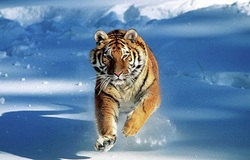The tiger population in India is moving towards extinction faster than we can say Tiger! Soon school excursions to tiger parks, adventure holidays to tiger sanctuaries or even a visit to the zoo to see the big cat will be a thing of the past!
Human encroachment of the natural habitat and poaching are the main causes for this travesty. We all need to wake up to this stark reality before we lose the national animal forever! Did you know.
* The earliest known portrayal of the Royal Bengal Tiger in India comes to us from the Indus Valley Civilization where a 2500 BC seal featuring a tiger was found.
* At the current rate of poaching and habitat loss, it is estimated that tigers in the wild could completely disappear within the next ten years
* Bengal Tigers are native to India, Nepal and Bangladesh.Tigers are fully grown at 3-4 years of age. Male Bengal tigers reach up to 230 kilograms and three metres in length, while the female Bengal tigers are 130-170 kilograms and up to 2.5 metres long
* Tiger stripes are like fingerprints. No two are the same. The stripes are not only in the tiger's fur, but are a pigmentation of the skin.
* At full running speed tigers reach up to 60 kilometres per hour.
* Tigers have a white spot on the back of both ears, which looks like eyes. This tricks predators into thinking the tiger is looking at them. This is why they are called 'eye spots
* A group of tigers is called a 'streak'.
* Tigers have two noses! Well, not literally of course. A secondary scent gland called 'Jacobson's organ' is located in the tigers mouth and is used in assisting the animals in identifying other scents.
* All tigers have a similar marking on their forehead, which resembles the Chinese symbol Wang, (King).
* The tail gives the tiger extra balance when running and is also used to communicate to other tigers.
* The tendons in a tiger's leg are so strong that it has been known to remain standing after it has been shot dead.

 RSS Feed
RSS Feed